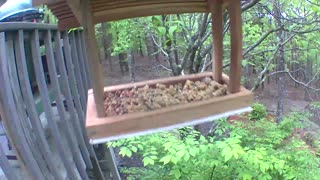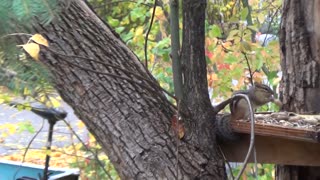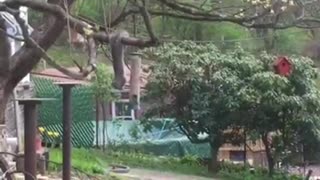Hairy A Woodpecker Perched And Eating On A Bird Feeder Hanging From A Tree Plant
A familiar visitor to bird feeders, the hairy woodpecker is named for the long, hair-like white feathers on its back. The hair looks like a super-sized version of a downy woodpecker, but the best way to tell these two similar species apart is to compare the length of the bill to the length (front-to-back) of the head. The hairy’s bill is always longer than the width of its head, and the downy’s bill is always shorter than the length of its head. An easier way to remember is: Downy is dinky; hairy is huge. Hairy woodpeckers are medium-sized woodpeckers (9 ¼ inches long) with a long, sturdy, chisel-like bill that is used for finding food, for excavating nest holes, and for territorial drumming on hollow trees. Males and females look the same with white bellies, a white central back stripe, and distinctly patterned black and white on faces and wings. Adult males, however, have a red patch at the back of the head.
Listen for
Hairy woodpeckers even sound bigger than downies. Their call note, peek! is sharper and louder than the downy’s, and the hairy’s rattle is lower and more emphatic and does not drop in pitch. They also drum on hollow branches.
Find it
Hairy woodpeckers are year-round residents across North America in mature forests and wherever there are large trees, including suburban backyards, urban parks, and isolated wood lots. They are one of our most widespread woodpeckers with a range extending into Central America.
Feeding Behavior
Using their bill, hairy woodpeckers can glean insects from tree bark or excavate them from beneath the bark’s surface. Primary diet items include beetles, spiders moth larvae, and ants, as well as fruits, seeds, and nuts. At bird feeders, hairies readily eat sunflower seeds, peanuts, suet, and cracked corn.
Nesting Behavior
It can take up to three weeks for a pair of hairy woodpeckers to excavate their nest cavity in the trunk or dead branch of a living tree. When completed, the nest cavity will have a 2-inch entry hole and will be 4 inches wide and as deep as 16 inches. Into this cozy space, four eggs are laid, and both parents share the roughly two-week incubation period. Less than a month after hatching, young hairy are ready to fledge from the nest, though the parents tend them for several more weeks. A new nest is excavated each spring, but old cavities are used for roosting at night and in winter.
WOW!
Some woodpeckers attack house siding. They may be able to hear wood-boring insects inside a tree trunk but mistake the hum of electricity in household wiring for insect activity.
-
 0:56
0:56
berkeleychefs
3 years agoBirds eating from a bird feeder - Berkeley Chefs
341 -
 2:16
2:16
GeaninaMedana
3 years agoSparrows eating from wild bird feeder
19 -
 0:43
0:43
Pelmorex_Eng
3 years agoEvening Grosbeak perched on a bird feeder
1 -
 1:00
1:00
debblock
3 years agoPileated woodpecker on feeder
13 -
 0:48
0:48
RumbleCanada
3 years agoChipmunk in bird feeder eating peanuts
361 -
 1:01
1:01
signguy1960
3 years ago $0.01 earnedSquirrel Hanging upside down on bird feeder
137 -
 1:19:23
1:19:23
Mally_Mouse
9 hours agoLet's Hang - Cosplay Stream!!
46.8K2 -
 1:05:06
1:05:06
Lou Dobbs
15 hours agoLou Dobbs Tonight 5-31-2024
62.4K36 -
 1:42:57
1:42:57
The Quartering
15 hours agoDonald Trump Conviction BACKFIRES, Massive Funds Raised, Democrats Swap Parties & More
102K98 -
 26:11
26:11
Stephen Gardner
13 hours ago🔴HUGE TRUMP WIN! Biden, Hillary, Obama ALL IN BIG TROUBLE NOW!!
95.2K388